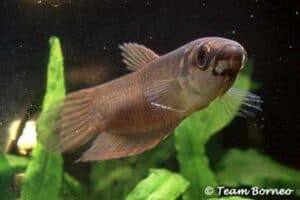Betta chini
This species was described in 1993 by Professor P.K.L. Ng. Betta chini is named after Dr. Phui Kong Chin. The genus name Betta comes from the Malay local name ikan betah for this species of fish.
Origin
The first specimen of this species (type specimen) was caught at Beaufort, Sabah, Borneo. Betta chini is known only from the Sabah region of Borneo.
Description
Betta chini was found in peat bogs less than half a meter deep. The bottom consisted mainly of leaves and peat. In general, this is a peaceful species that is best kept in small groups. The calmness depends on the females; cases have been described where nothing happened but there have also been cases where the males were violently chased and even wounded by the females. This behavior varies among individuals and shows itself only for reproduction.
Betta chini requires a reasonably sized aquarium which should be richly planted. Floating plants are also very important, especially to dampen the light; this species does not like a lot of light. In brown or tea-colored water, this species shows the most beautiful colors and feels most comfortable. Since they occur in peat bogs, the water plays an important role. Therefore, the values measured in the natural biotope should be replicated; pH 4.5 to 5, GH lower than 3 and the measured temperature was 26.4°C.
It is a fairly small Betta species. They can reach a maximum length of about 6 inches.
Reproduction of Betta chini
Betta chini is a mouthbreeder. After 1 to 3 successful entanglements during reproduction, the male and female mate side by side. Then an interesting “ball game ensues;” the female spits single eggs at the male 1 to 8 times. Immediately the female picks them all up again, unless the male is faster. Eventually the male has all the eggs in his mouth. The total number of eggs varies between 40 and 50 which are spat out after 12 days. At that time the young already have a length of 6 mm. At that time the male loses interest in the young but they can stay in the same tank as the male and female; Betta chini does not show cannibalism. This is only possible if the tank is large enough, with a smaller tank it is advisable to remove the female first and then the male from the tank.
Stefan vd Voort – Dutch Association for Labyrinth Fish
Published in consultation with the board
Copyright images
Professor P.K.L. Ng
H. Linke









